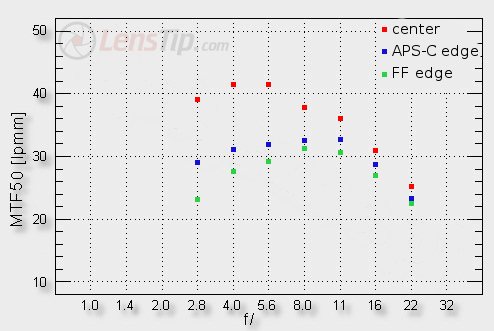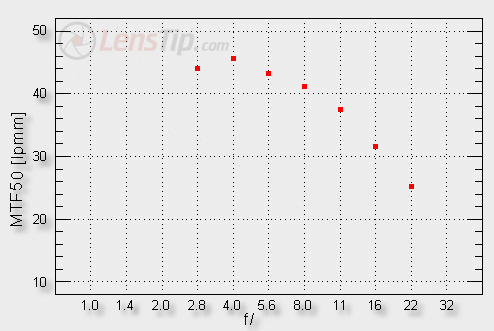Canon EF 14 mm f/2.8L USM II
4. Image resolution
How the tested lens compares ? Let’s glance at the graph below where we present its results in the frame centre, on the edge of the APS-C sensor and full frame.

Please Support UsIf you enjoy our reviews and articles, and you want us to continue our work please, support our website by donating through PayPal. The funds are going to be used for paying our editorial team, renting servers, and equipping our testing studio; only that way we will be able to continue providing you interesting content for free. |
- - - - - - - - - - - - - - - - - - - - - - - - - - - - - - - - - - - - - - - - - - - - - - - -
It would be difficult to express any reservations about the frame centre – even at the maximum relative aperture the lens fares very well there. On slight stopping down the achievements are even improved. The problem is that the expensive Canon doesn’t show anything different from the rival cheap Samyang 2.8/14, which actually fared minimally better here.
What’s more, when we look at the performance on the edge of the frame the situation is not so rosy anymore. When on the edge of the APS-C sensor we are still within the decency level or maybe a bit above it, on the edge of full frame the results are no good. To enjoy a fully useful image there we must stop the lens down very significantly - to f/8.0. Once again these results don’t present themselves very favourably, especially when compared to the cheap Samyang which, by and large, is a tad sharper everywhere.
Why the Canon has so many problems with reaching high results? Two off-axis aberrations – the lateral chromatic aberration and astigmatism – are the answer. Their influence on the image quality we are going to describe in more detail in the appropriate chapters. Here we would like to show how the performance of the Canon might have looked if these aberrations had been properly corrected. We can assess it properly by taking only the MTFs on the vertical borderline between white and black into account, setting the focus in such a way so the astigmatism on the vertical border is reduced to the minimum and the chromatic aberration’s influence isn’t felt, as it doesn’t concern radial borderlines.

The graph above shows simply excellent results. The lens reaches maximum values on the level of 44-46 lpmm already near the maximum relative aperture. It’s a pity we can see them only on the vertical borderlines whereas at the same moment on the horizontal borderlines they are by several dozen percent lower.
Below we present the results for the frame centre taken from the photos of our test chart saved as JPEG format. The influence of chromatic aberration, mentioned before, is visible here too although that crop comes from an area near the frame centre.
 |






